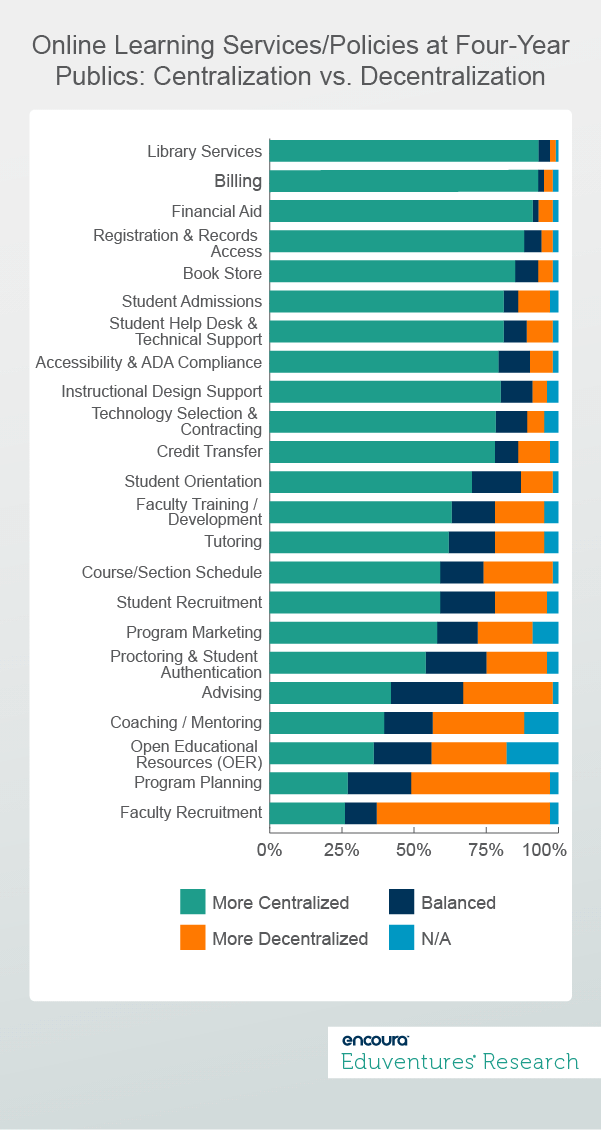A Message from our Chief Research Officer: While the priority right now is the safety of students, faculty, and staff, the continuity afforded by online learning is precious—however rudimentary arrangements may be on the ground. Our thanks and admiration go out to the thousands of online leaders, staff, and online learning company employees going above and beyond to stand up remote classes in short order. That so many schools could even consider “going online” in an emergency is testament to how far online has come.
We know many of our readers are very busy right now. Whether you have time now or later, we think you might enjoy reading about our latest CHLOE (Changing Landscape of Online Education) report, available at no cost to our Wake-Up Call readers.
As COVID-19 casts aside certainties of campus and classroom across American higher education, the title of the latest Changing Landscape of Online Learning (CHLOE) report, CHLOE 4: Navigating the Mainstream, available for download today but written pre-crisis, seems both prescient and a giant understatement.
Today, online learning has suddenly gone mainstream to an extent unimaginable just a few weeks ago.
As the virus continues to spread throughout the U.S. and schools search for good-enough answers to head-spinning conundrums, CHLOE, a project run by Eduventures and Quality Matters, offers important perspective on everyday online learning.
Ordinary Online
CHLOE 4: Navigating the Mainstream refers to the steady normalization of online courses and programs across many school types and fields of study, the range of online strategies and policies, and the expanding role of online leaders on campus—all chronicled in the report. In 2019, more than a third of undergraduate and graduate students in the U.S. were studying fully or partly online, up strongly over the past decade. The CHLOE 4 survey of online leaders at 367 colleges and universities was completed in 2019.
Amid a pandemic, online can , even if emergency “online learning” is a far cry from best practice. While CHLOE is not a primer for emergency online, two timely questions to ask of the CHLOE 4 report are:
- How can CHLOE 4 help higher education in the throes of rapid online learning deployment?
- What does the report imply about the direction of travel for online learning (allowing for the mighty variable of a pandemic)?
The value of the CHLOE series, in both normal times and today’s abnormal environment, is an account of online learning as it really is. Market hype and product pitches are put aside to reveal how little online has moved forward, as well as how far it has come.
The CHLOE 4 report, like its predecessors, seeks to illuminate how real institutions are striving to make online work in their contexts, with all the trade-offs that involves. Here are some examples of compromise and work-in-progress, according to CHLOE 4:
- Course Design. Many schools now employ instructional designers, but the most common institutional policy is for individual faculty members to choose whether to work with them.
- Training & Orientation. Despite growing online enrollment, most schools do not insist on training for faculty or on first-course student orientation.
- Pricing. The norm remains to price online programs the same as campus ones, despite apparent wide variation in underlying costs.
- Accessibility. Online course accessibility remains fragmented and inconsistent, hampered by divergent definitions.
Working with—as well as against—the prevailing culture is inevitable for any innovation. Online leaders at many schools are still navigating the competing virtues of centralization and decentralization in a culture where decentralization is often prized. The delivery mode only got off the ground because individual faculty were routinely encouraged to take the lead on which courses and programs went online and how. This resulted in a healthy variety of approaches but also a duplication of effort, uneven quality, and a murky understanding of cost dynamics.
The CHLOE 4 report offers evidence of a more centralized approach emerging at many schools in the interests of quality student experience and management of scale. In most online learning service and policy domains, CHLOE 4 shows only a minority of schools cede most decision-making to academic departments.
Figure 1 looks at public four-year schools as an example.

Centralization vs. Decentralization
For many services and policy areas, Figure 1 says that centralization is very much the norm. More academic matters, such as advising and program planning, straddle centralizing and decentralizing instincts. It is notable that few schools, for any service or policy, report a balanced approach, suggesting clearly defined areas of responsibility and cultural turf. Similarly, CHLOE 4 reveals that few schools administer online students entirely separately from on-campus students, even while a distinct approach can be helpful in the early days.
CHLOE 4 is not a guide to online learning as crisis management, but it provides a useful way to gauge what “normal” online higher education looks like, how different school types depart from norms, and where different issues are heading. At many schools in 2020, online learning, pre- and now mid-crisis, is indeed an integral part of the institutional fabric, a fact that greatly aids “emergency online.”
The Bottom Line
Despite two-plus decades of online learning, almost zero traditional-aged undergraduates opt for it wholesale over campus attendance. It may be that when the crisis abates, very few of these “traditional” undergraduates will look back on online as anything more than a necessary, but temporary, inconvenience, and a poor imitation of “college.”
Indeed, one might argue that few adult learners or graduate students are convinced of the pedagogic advantages of online learning. Online is first and foremost a matter of practicality, even if some instructors or institutions do it really well. Online leaders worry that today’s mass, hastily-constructed “remote instruction”—only a shadow of “real” online learning—might turn-off Gen-Z for good. Perhaps another perspective is that once Gen-Z’ers hit their late 20’s, have a demanding job, and start a family, the value of online learning will become readily apparent.
But can online think bigger? As higher education writ large strives for wider access, cost control, and quality enhancement, online learning has thus far played a diffuse role. Too frequently, studies conclude that the students most in need of alternatives struggle the most online. Cost opacity or inconsistency inhibits the transformative economies of scale seen in other sectors, and at the undergraduate level, online program completion rates are often lackluster.
The CHLOE survey is a valuable lens on the evolution of online learning: how years of experimentation, debate, and practice are gradually creating models that transcend rather than imitate the traditional campus, leveraging online where it is most impactful, and taking on higher education’s core challenges. Creative combinations of campus and online may be the way forward for most schools rather than a false choice between them. Blended learning tailored to school mission or field of study is the future, not one-size-fits-all.
The CHLOE 4 report was made possible through the partnership of QM and Eduventures Research — the research division of ACT® | NRCCUA® — and the support of sponsors iDesign, ExtensionEngine and Instructional Connections.

Never
Miss Your
Wake-Up Call
Learn more about our team of expert research analysts here.
Eduventures Chief Research Officer at ACT | NRCCUA
Contact

